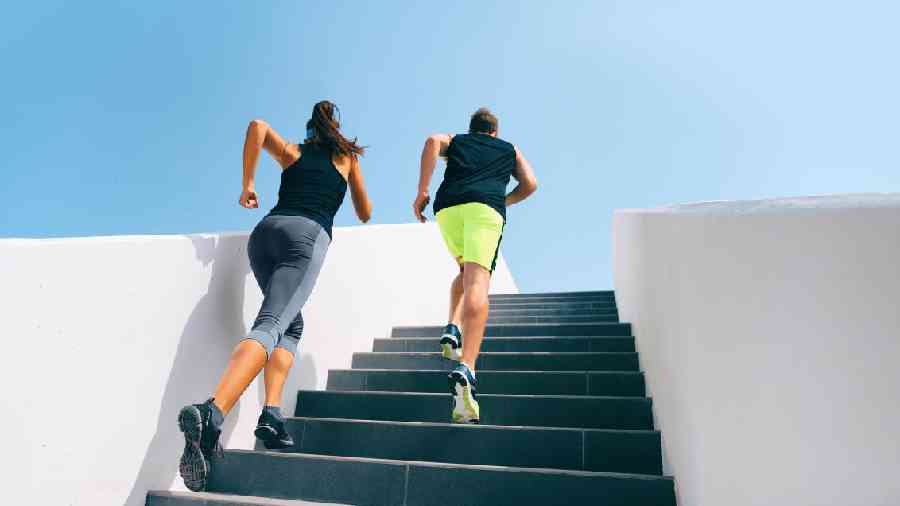Workout trends come and go, but when it comes to the biggest bang for your buck, high intensity interval training, or HIIT, has staying power.
HIIT’s specific origins are uncertain; some say it dates back to at least the early 1900s and Finnish Olympic runners who would use alternating short bursts of intensity with brief bouts of recovery to bolster their overall speed. Today, it remains one of the “Top 20 Worldwide Fitness Trends” according to the American College of Sports Medicine.
A true HIIT session will incorporate several rounds of short high-intensity cardiovascular bursts — usually lasting not more than 20 seconds — followed by brief periods of rest. This allows you to complete a workout that delivers substantial fitness results in just 30 minutes or so. It usually requires little to no equipment, and you can pick your preferred method of cardio.
When added to a regimen of standard cardio exercise and strength training, HIIT can boost your overall fitness, improve health metrics, increase your calorie burn rate and lead to better performance in competitive sports. Here’s how to reap those benefits.
Why HIIT?
The chief argument for an HIIT workout is its potential to produce cardiovascular fitness gains in a short amount of time.
A 2019 review of research studying the health benefits of HIIT found that it was a more efficient approach to aerobic training, compared to steady-state cardio exercise — which keeps your heart rate in the same general range for an extended period. A small 2020 study of sedentary men between the ages of 43 and 73 found that performing HIIT over just six weeks significantly decreased their high blood pressure.
In addition to improving heart health, many people choose HIIT as a means to lose weight, said Cedric Bryant, president and chief science officer of the American Council on Exercise. “You will always get a higher average calorie burn from a HIIT session than a steady-state session for the same amount of time.”
And while this may be true, the best reason to incorporate HIIT into your exercise routine, according to Wilson, is to improve performance, whether you’re a competitive athlete or not. Performance, she explained, means training your whole body to move efficiently and with more agility.
What is 'real' HIIT?
There’s a lot of confusion around what counts as HIIT. Some gyms or trainers refer to any circuit training — a variety of exercises done one after the other — as HIIT. While these workouts might be difficult, most won’t get your heart rate high enough to qualify. For instance, a runner sprinting for 3 to 5-minute spurts with rests in between is running intervals, but not doing HIIT.
CrossFit is another workout people commonly mistake for HIIT, Wilson said. “CrossFit is not HIIT, although a CrossFit workout may enlist an HIIT circuit within it,” she explained. “But they are definitely not one and the same.”
An actual HIIT session — the short-bursts portion of the workout that causes an accelerated heart rate — might be only 10 minutes long, especially for beginners. However, “you will also take 5 to 10 minutes to slowly warm up with gentler movement, perform your chosen HIIT circuit, then cool down for 5 to 10 minutes,” said Sabrena Jo, an exercise and health scientist with the American Council on Exercise.
Getting started
For those new to HIIT, a session once per week is a good starting point. While you can do an HIIT session by itself, Wilson often does one at the end of another workout. “I might pair it with leg day, for instance,” she said, doing “super sets” of combined movements like squats and lunges, and then finishing with a 10-minute HIIT workout.
Once you are comfortable with them, aim for two to three sessions per week, but not more, said Holly Roser, a personal trainer in San Francisco, US. “After that, you could become more susceptible to injury.”
Avoid HIIT if you have a cardiac condition, are recovering from an injury or regularly experience vertigo. If you’re pregnant, consult with your doctor before you start.
In the beginning, you might have to shorten the length of an interval or two to catch your breath, said Roser, or find yourself slowing down toward the end of a session. But after about a month of regular HIIT sessions, you should be able to get through one and notice an improvement, for instance, in how fast you can run, bike or row on an ergometer. By then you can try tweaking the ratio of exercise to rest so that you rest for shorter periods of time.
The simplest workout
If you’re new to the HIIT format, a good way to ease in is to pick a single cardio-focused machine or exercise. The treadmill is often the least intimidating for beginners. After a warm-up, try sprinting as fast as you can for 10 seconds, then walking or resting for 50 seconds. Repeat this six times.
That’s it, you’re on your way to mastering HIIT. As you get comfortable, try shortening the rest periods to 20 seconds, and then even 10.
NYTNS










